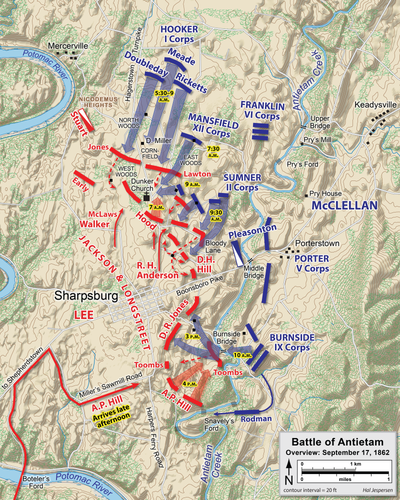
Lee and McClellan's armies at Sharpsburg were arrayed for battle roughly along Antietam Creek. The landscape was that of rolling farmland and groves of trees, and Lee was in a strong defensive position, but no where near impregnable. His army was along an approximately four mile long low ridge overlooking the valley containing the creek. Both of his flanks were anchored along the sides of a bend in the Potomac River. Although this meant that he could not be flanked, it also meant that if defeated it would be very difficult to make an orderly retreat. Lee's position could be broken down into three parts, distinguished by recognizable landmarks. On the left was Jackson's Corps around Dunker Church and the Cornfield. In the center was D. H. Hill's division along the Sunken Road, a road bordered by fences which formed a natural trench. On the right was Longstreet's Corps, and the landmark there was what was later called Burnside's Bridge over Antietam Creek. By the time Lee was attacked on the 17th, all of his scattered troops had arrived except for A. P. Hill. His division was on it's way from Harper's Ferry, and would arrive sometime that day.
 |
| Antietam |
McClellan, after personally examining the Confederate position, decided to attack the Confederate left. On the right the bridges were overlooked more closely by the bluffs. He hoped to overwhelm the left and then move South down the ridge, driving Lee off the ridge and into the Potomac. He also ordered attacks to be made on the center and right, which would serve as diversions, and could also be turned into a main attack if successful. Fighting Joe Hooker's and Mansfield's corps would attack on the Confederate left, Franklin and Sumner would be available to attack there or in the center, Burnside would attack the right, with Porter in reserve to resist a counter attack. In the afternoon of the 16th McClellan had his troops moving into position. Troops began crossing the creek over the North bridge to get in position for the fight of the next day. McClellan's plans would not be put into coordinated execution. The corps commanders dd not communicate well, and through the rolling nature of the ground they could not do it by sight. At his headquarters in the rear, McClellan exercised little direct control. The battle therefore occurred in three separate phrases, with little connection to each other from the Union perspective.





0 comments:
Post a Comment